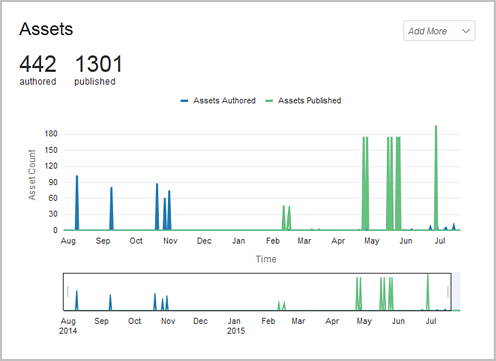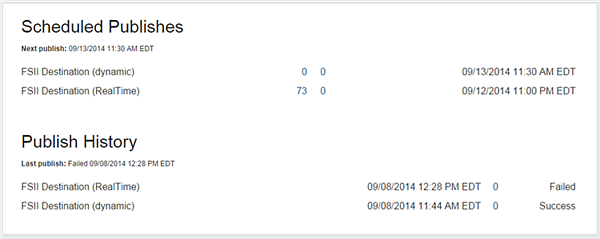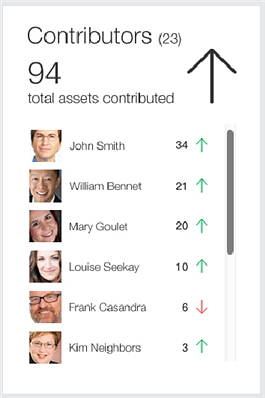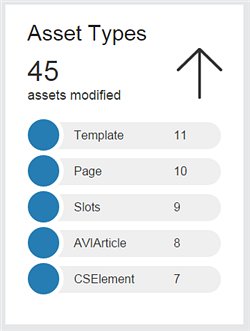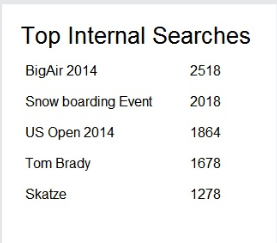10 Working With the Content Audit Report
Note:
To view the Content Audit report, you must be assigned the MarketingAuthor role.For information about working with the Content Audit report, see these topics:
10.1 Viewing the Content Audit Report
To view the Content Audit report:
10.2 Content Audit Report Metrics Bar
The Content Audit report's metrics bar (shown in Figure 10-2) contains tickers that display authoring statistics, such as the total number of assets edited, for the selected reporting period.
Table 10-1 provides information about each ticker in the Content Audit report's metrics bar:
Table 10-1 Content Audit Metrics Bar Tickers
| Ticker | Description |
|---|---|
|
total assets |
Indicates the total number of assets in the site during the reporting period. |
|
edited assets |
Indicates the number of assets that were edited during the reporting period. Click the number shown above the edited assets ticker to open a Search tab listing all the assets that were edited during the selected time period. |
|
new assets |
Indicates the number of the assets that were created during the reporting period. Click the number shown above the new assets ticker to open a Search tab listing all the assets that were created during the selected time period. |
|
workflow assignments |
Indicates the number of workflow assignments that were completed during the reporting period. -OR- Indicates the number of workflow assignments in progress for the current reporting period. Click the number shown above the workflow assignments ticker to open a Search tab listing all the assets that are part of a workflow assignment during the selected time period. |
|
checkedout assets |
Indicates the number of assets that have been checked out by Contributor interface users during the reporting period. Click the number shown above the checkedout assets ticker to open a Search tab listing all the assets that have been checked out during the selected time period. |
|
placed pages |
Indicates the number of pages that have been placed under a site navigation in the Site Tree during the reporting period. Click the number shown above the placed pages ticker to open a Search tab listing the pages that have been placed under a site navigation node during the selected time period. |
|
unplaced pages |
Indicates the number of pages under the Unplaced Pages node in the Site Tree during the reporting period. Click the number shown above the unplaced pages ticker to open a Search tab listing all the pages that have been unplaced during the selected time period. |
10.3 Authoring Statistics Chart
The Authoring Statistics chart (shown in Figure 10-3) plots the number of assets authored (created and edited) against the number of assets published during the selected time period, excluding technical assets such as Template assets.
This chart contains an Add More drop-down menu that enables you to view edited assets, checked out assets, and assets that are held for publishing on the chart in addition to the number of assets that were authored and published during the selected time period. Selecting a value from the Add More drop-down menu introduces a third line on the chart that plots the data related to the selected option.
Table 10-2 provides information about the Add More drop-down menu options.
Table 10-2 Authoring Statistics Chart Options
| Option | Description |
|---|---|
|
Edited |
Displays a third line on the chart that plots the number of assets that were edited during the reported time period. |
|
Checked out |
Displays a third line on the chart that plots the number of assets that have been checked out during the reported time period. |
|
Held |
Displays a third line on the chart that plots the number of assets that have been held for publishing during the reported time period. |
10.3.1 Publish Details Reports
The Publish Details report (shown in Figure 10-4) provides details about publishing history and scheduled publishing jobs for the selected time period.
The Scheduled Publishes report provides information about the publishing jobs scheduled for the selected time period, with the date of the next scheduled publishing session shown at the top. Table 10-3 provides information about each column in the Scheduled Publishes report.
Table 10-3 Scheduled Publishes Report
| Column | Description |
|---|---|
|
Destination |
The name of the publishing destination. |
|
Publish Time |
The date the publishing event will occur. |
|
#Assets |
The number of assets involved in the publishing event. Click the number of assets to view a list of assets to be published during the scheduled publishing event. |
|
#Assets Held |
The number of assets that are held (not being published) during this scheduled publishing event. |
The Publish History report contains information about publishing events that occurred during the selected time period, in reverse chronological order, with the most recent publishing event shown at the top. Table 10-4 provides descriptions for each column in the Publish History report.
Table 10-4 Publish History Report
| Column | Description |
|---|---|
|
Publisher |
The name of the user who triggered the publishing session. |
|
Destination |
Name of the publishing destination. |
|
Publish Date |
The date on which the publishing job ran. |
|
Status |
Shows the status of the publishing job. Possible values:
|
|
#Assets Published |
Shows the number of assets published for a particular publishing job. |
|
#Assets Held |
Shows the number of assets that were held (not published) during the publishing job. |
10.4 Author Productivity Report
The Author Productivity report (shown in Figure 10-5) displays information about the content contributors who created and edited assets in the selected time period, on the given content management site.
The top of the report displays the number of contributors who created and edited assets and the total number of assets that were created and edited during the selected time period. It also displays a trend arrow which points up or down. An upwards pointing arrow indicates a positive trend, which means more assets were worked on during this time period than the previous time period. A downward pointing arrow indicates a negative trend, which means fewer assets were worked on during this time period compared to the previous time period.
Below the number of assets that were created and edited is a list of users who have contributed content during the selected time period. To the right of each user's name and profile picture is the number of assets the user has worked on during the current time period and a trend arrow indicating whether this number is higher or lower than the number of assets the user worked on during previous time periods.
10.5 Content Tag Cloud
The Content Tag cloud (shown in Figure 10-6) displays the most common tags that were applied to assets during the selected time range.
The larger the text of the tag, the more often it is used to tag content. By default, the cloud shows the top 50 tags. When you click a tag in the cloud, a search is run for all the assets that are tagged with this content.
10.6 Asset Types List
The Asset Types list (shown in Figure 10-7) displays a list of the top five asset types on which users performed create and edit operations during the selected time range, on the given content management site.
The total number of new and modified assets of the top five types is shown at the top of the list. Next to each asset type in the list is the number of assets of that type that were created or edited during the reported time range, and a trend arrow shows whether more or less assets of these types were created and edited during this time range compared to the previous time period.
10.7 Top Internal Searches List
The Top Internal Searches list (shown in Figure 10-8) lists the top 10 search words and phrases that Contributor interface users entered into the Search field during the reported time range. To the right of each keyword is the number of times it was used during the reported time range. Click a keyword to view the resulting search results.


